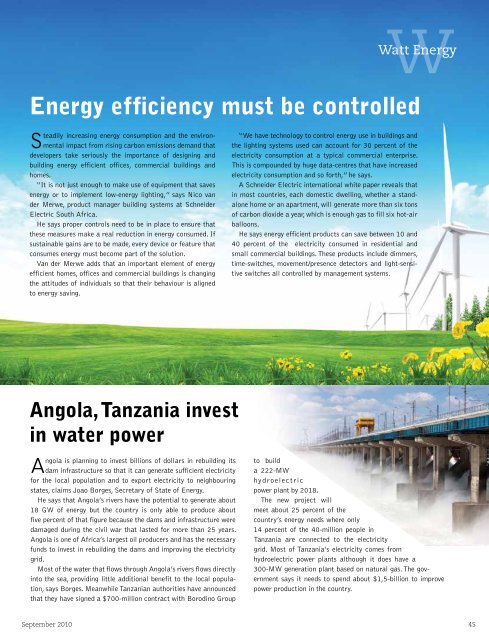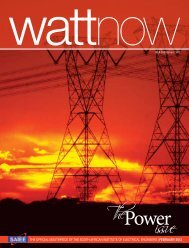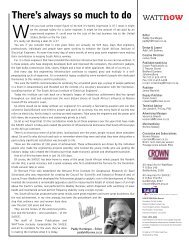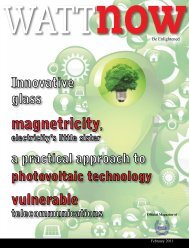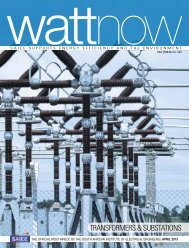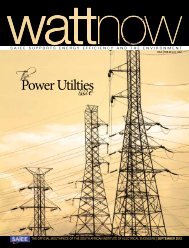download a PDF of the full September 2010 issue - Watt Now ...
download a PDF of the full September 2010 issue - Watt Now ...
download a PDF of the full September 2010 issue - Watt Now ...
- No tags were found...
Create successful ePaper yourself
Turn your PDF publications into a flip-book with our unique Google optimized e-Paper software.
W<strong>Watt</strong> EnergyEnergy efficiency must be controlledSteadily increasing energy consumption and <strong>the</strong> environmentalimpact from rising carbon emissions demand thatdevelopers take seriously <strong>the</strong> importance <strong>of</strong> designing andbuilding energy efficient <strong>of</strong>fices, commercial buildings andhomes.“It is not just enough to make use <strong>of</strong> equipment that savesenergy or to implement low-energy lighting,” says Nico vander Merwe, product manager building systems at SchneiderElectric South Africa.He says proper controls need to be in place to ensure that<strong>the</strong>se measures make a real reduction in energy consumed. Ifsustainable gains are to be made, every device or feature thatconsumes energy must become part <strong>of</strong> <strong>the</strong> solution.Van der Merwe adds that an important element <strong>of</strong> energyefficient homes, <strong>of</strong>fices and commercial buildings is changing<strong>the</strong> attitudes <strong>of</strong> individuals so that <strong>the</strong>ir behaviour is alignedto energy saving.“We have technology to control energy use in buildings and<strong>the</strong> lighting systems used can account for 30 percent <strong>of</strong> <strong>the</strong>electricity consumption at a typical commercial enterprise.This is compounded by huge data-centres that have increasedelectricity consumption and so forth,” he says.A Schneider Electric international white paper reveals thatin most countries, each domestic dwelling, whe<strong>the</strong>r a standalonehome or an apartment, will generate more than six tons<strong>of</strong> carbon dioxide a year, which is enough gas to fill six hot-airballoons.He says energy efficient products can save between 10 and40 percent <strong>of</strong> <strong>the</strong> electricity consumed in residential andsmall commercial buildings. These products include dimmers,time-switches, movement/presence detectors and light-sensitiveswitches all controlled by management systems.Angola, Tanzania investin water powerAngola is planning to invest billions <strong>of</strong> dollars in rebuilding itsdam infrastructure so that it can generate sufficient electricityfor <strong>the</strong> local population and to export electricity to neighbouringstates, claims Joao Borges, Secretary <strong>of</strong> State <strong>of</strong> Energy.He says that Angola’s rivers have <strong>the</strong> potential to generate about18 GW <strong>of</strong> energy but <strong>the</strong> country is only able to produce aboutfive percent <strong>of</strong> that figure because <strong>the</strong> dams and infrastructure weredamaged during <strong>the</strong> civil war that lasted for more than 25 years.Angola is one <strong>of</strong> Africa’s largest oil producers and has <strong>the</strong> necessaryfunds to invest in rebuilding <strong>the</strong> dams and improving <strong>the</strong> electricitygrid.Most <strong>of</strong> <strong>the</strong> water that flows through Angola’s rivers flows directlyinto <strong>the</strong> sea, providing little additional benefit to <strong>the</strong> local population,says Borges. Meanwhile Tanzanian authorities have announcedthat <strong>the</strong>y have signed a $700-million contract with Borodino Groupto builda 222-MWhydroelec tricpower plant by 2018.The new project willmeet about 25 percent <strong>of</strong> <strong>the</strong>country’s energy needs where only14 percent <strong>of</strong> <strong>the</strong> 40-million people inTanzania are connected to <strong>the</strong> electricitygrid. Most <strong>of</strong> Tanzania’s electricity comes fromhydroelectric power plants although it does have a300-MW generation plant based on natural gas. The governmentsays it needs to spend about $1,5-billion to improvepower production in <strong>the</strong> country.<strong>September</strong> <strong>2010</strong> 45


